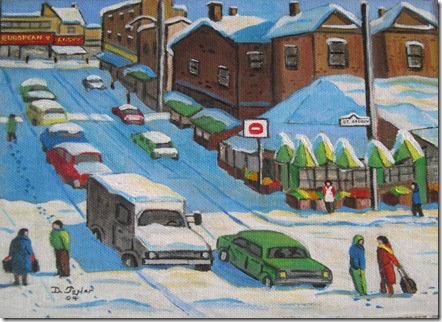The Kensington Market is magical at Christmas time, the colourful fruits and festive products of the season spilling over onto the sidewalk stalls. Shoppers crowd the narrow streets, entering shops where yuletide favourites from around the world delight the eye. If you are able to view the market after a snowstorm, the snow-capped awnings and umbrellas add to the mood of Christmas.
“After the Storm”
The Kensington Market, looking north up St. Andrew’s Avenue toward Baldwin Street, acrylic on stretched canvas, 8” x 10”
The following quote is from the introduction of the section in the book “The Villages Within” that introduces the section on the Kensington Market. The book was nominated for the 2011 Toronto Heritage Awards.
Torontonians do not usually refer to the Kensington Market as a “village.” The dictionary defines a village as “a group of homes that is larger than a hamlet and smaller than a town.” However, as anyone who has experienced the villages of Ontario can verify, a village is much more than this. Villages have boundaries, alerting travelers when they have arrived within its precincts and when they have departed. Every village has a different character and an atmosphere that throughout the decades the villagers have created.
This is true of “Kensington.” The residents tend to be community oriented, many of them maintaining a keen sense of neighbourhood. Although they have valves that they hold in common, they also have a true sense of individualism. Many of the residents are environmentalists, enjoy health foods, and strongly support recycling. As well, many ethnic groups reside within the area.
Others are aging hippies, leftover flower children, and leather types. Some follow lifestyles that defy categorization. Yet there are also those whose lifestyle is indistinguishable from other residents of the city. It is evident that a few are restoring their homes to capture the appearance of the nineteenth century, rather than simply renovating, as they have a keen interest in the history of the area. The Market has a few colourful eccentrics who are well accepted and considered an integral part of the scene.
Other cities in the world have districts within their boundaries that are similar to Kensington, forming small enclaves that maintain their unique character despite the passage of time. They too share common characteristics, but no two are ever alike. Although many have historic homes and quaint shops, nowhere is there another Kensington.
It is “one of a kind”—a chaotic collage of diversity.
Richard Florida, in his book The Rise of the Creative Class, discusses places where the residents are seeking an environment that is open to differences, where highly creative people are welcomed, regardless of ethnic background, income, creed, or sexual orientation. They prefer locations where there multiplicity is accepted, where odd personal habits or extreme styles of dress are not only welcomed, but also celebrated. Unusual marital arrangements and varied partnership relations fail to attract any attention.
Kensington is such a place, and is truly “a village within.”
